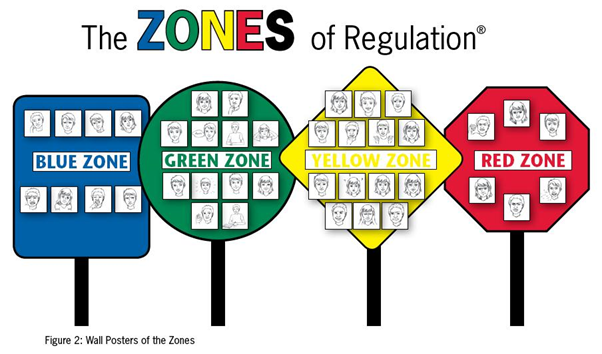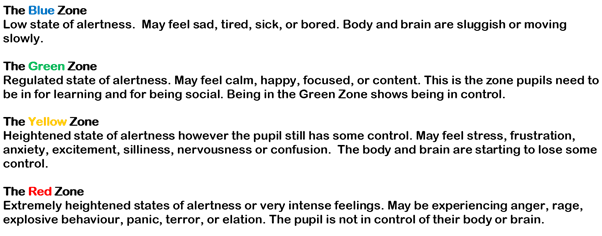Zones of Regulation

The Zones of Regulation is a conceptual framework used to teach pupils self-regulation and self-control, created by Occupational Therapist Leah Kuypers.
Self-regulation can be described as the ability to adjust your level of alertness to fit the situation you are in and express this through socially appropriate behaviours. For example, the level of alertness required to read a book in a library and that needed to compete in a football match are very different, and the socially expected behaviours in each situation would also differ. Self-regulation encompasses the skills of self-control, resilience, anger management, impulse control and sensory regulation.
Using The Zones at St. Peter’s
In September 2020 we took the decision to roll out our use of The Zones of Regulation, previously used with identified individuals, as a whole school approach. This has helped us develop a common language across the school through which to discuss emotions and behaviours.
Teachers share the content of the curriculum flexibly with their classes in line with their age and stage of development and in response to the needs of the cohort. Some individuals and small groups work more intensively with the materials to support their particular needs. Content is also covered in assemblies for the whole school to access and all classrooms have The Zones on display.
Classes have developed their own agreed systems and strategies to help pupils move between zones. Some individuals may also have personalised ‘toolboxes’ of strategies specific to them and their needs.
Aims of using The Zones at St. Peter’s
- To help pupils recognise when they are in the different Zones and how to change or stay in the Zone they are in.
- To gain an increased vocabulary of emotional terms so pupils can explain how they are feeling.
- To gain insight into events that might make them move into the different Zones e.g. disagreement with a friend, a lesson or a fire drill.
- To help pupils understand that emotions, sensory experiences, physiological needs (e.g. hunger/lack of sleep) and environments can influence which Zone they are in.
- To develop problem-solving skills.
- To identify a range of different calming and alerting strategies/tools that support them.
What are the Zones of Regulation?
 (Leah M. Kuypers, 2011)
(Leah M. Kuypers, 2011)

- It is important to know that it's fine for pupils to experience all of these emotions while they're at school.
- Pupils may also be in more than one zone at a time.
- There is no bad zone, but it is important to learn and use strategies that would help pupils get to their Green Zone.
- Some emotions may fall into more than one Zone
Key Language
- Toolbox: a collection of calming and alerting strategies a pupil can draw upon
- Tools: calming or alerting strategies that support self-regulation
- Trigger: something that causes the pupil to become less regulated and increases the likelihood of going into the Yellow or Red Zones
- Stop, Opt, Go: a concept to aid pupils in controlling impulses and problem solving better solutions
- Expected behaviours: behaviours that give those around you good or comfortable thoughts about you
- Unexpected behaviours: behaviours that give people uncomfortable thoughts about you
- Inner Critic: negative, self-defeating thoughts
- Inner Coach: positive, helpful thoughts
Using the Zones of Regulation at Home
While it's not mandatory to use this programme at home, you may like to try:
- Identifying your own feelings using Zones language in front of your child e.g. “I’m feeling frustrated because….. , I am in the Yellow Zone.”
- Talking about which tool you will use to be in the appropriate Zone e.g. “I’m going to go for a walk as I need to get to the Green Zone.”
- Providing positive reinforcement when your child is in the Green Zone and if they make efforts to stay in the Green Zone e.g. “I can see you are working really hard to stay in the Green Zone by…”
- Labelling which Zones your child is in throughout the day e.g. “You look sleepy, I wonder if you are in the Blue Zone?”
- Teaching your child which Zone tools they can use e.g. “It’s time for bed, let’s read a book together to get to the Blue Zone.”
- Displaying and using the Zones visuals and tools in your home.
If you would like more information on the strategies your child is using at school or you would like copies of resources to use at home, please contact your child’s class teacher or Sarah Davis, the SENCO.
